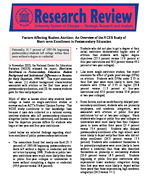Factors Affecting Student Attrition: An Overview of the NCES Study of Short-term Enrollment in Postsecondary Education
Nationally, 31.7 percent of 1995-96 beginning postsecondary students left college within three years without a degree or credential.
In November 2002, the National Center for Education Statistics (NCES) released the report, Short-term Enrollment in Postsecondary Education: Student Background and Institutional Differences in Reasons for Early Departure, 1996-98.1 This report examines two issues: (1) student background characteristics associated with attrition in the first three years of postsecondary education, and (2) the reasons students gave for their early departure.
Much of what is known about why students leave college is based on single-institution studies or surveys such as ACT's Student Opinion Survey. This NCES study contributes to that knowledge base because it uses data collected in a national survey, involves students who left postsecondary education altogether (rather than one institution), and focuses on how the departure process differs for students who begin at two-year and four-year institutions.
Listed below are selected findings regarding shortterm enrollees of public postsecondary institutions.
The researchers found that nearly one-third (31.7 percent) of 1995-96 beginning postsecondary students left without a degree or credential and did not return by spring 1998. Students in public twoyear institutions were much more likely than those in public four-year colleges or universities to leave without completing a degree or credential (43.6 percent versus 18.8 percent).
Students who did not plan to get a degree at their initial institution demonstrated higher rates of attrition than students with higher degree objectives (27.7 percent versus 17.9 percent at four-year institutions and 59.0 percent versus 43.0 percent at two-year colleges).
Like some single-institution studies, this report examines the effect of grade point average (GPA) on attrition. Students with GPAs under 2.75 in their first year were more likely to leave than students with GPAs of 2.75 or higher (25.8 percent versus 11.3 percent at four-year institutions and 47.9 percent versus 37.8 percent at two-year colleges).
Some factors, such as race/ethnicity, delayed postsecondary enrollment, students who are primarily employees, and academic integration, were associated with attrition at public four-year institutions but not at two-year colleges. Black students who began at public four-year colleges or universities were more likely than their Hispanic peers to leave within three years (21.4 percent versus 13.4 percent). Students who delayed postsecondary enrollment after high school were more likely to depart early than those who did not delay enrollment (24.3 percent versus 17.5 percent). Students who considered themselves to be primarily employees were more likely to leave without a credential than those who described themselves as primarily or exclusively students (25.6 percent versus 18.3 percent). Students beginning at public four-year institutions who experienced lower academic integration during their first year were more likely to depart within three years than those experiencing high academic integration (24.2 versus 17.1).
Employment while enrolled was associated with departure for students who began at two-year colleges but not for those who started at four-year institutions. Students who did not work or who worked part time during their first year of college had a lower attrition rate than those who worked full time (37.2 percent, 39.3 percent, and 53.0 percent, respectively).
The most common reasons students gave for leaving postsecondary education without a degree or credential are listed in the table below.
Students who began at public two-year institutions were more likely than students who began at public four-year institutions to report they left because they had completed their desired classes (12.0 percent versus 4.7 percent) or because they needed to work (29.0 percent versus 16.8 percent). However, students who began at four-year institutions were more likely than students who began at public two-year institutions to indicate they left because of academic problems (9.0 percent versus 2.0 percent) or a change in family status (12.4 percent versus 5.8 percent).
Reasons for Leaving
Percent
Needed to work
26
Other financial reasons
16
Completed desired classes
10
Conflicts at home/personal reasons 10
Change in family status
8
Taking time off
7
Not satisfied
6
Conflicts with job/military
6
Academic problems
4
Gender was related to some reasons for departure in the multivariate analyses. Female students who left were less likely than their male peers to leave for academic reasons (2.1 percent versus 6.1 percent) but more likely to leave because of a change in family status (10.9 percent versus 3.9 percent).
For more information, write or e-mail: Dr. Susan Campbell
Policy Research Associate Board of Regents of the University System of Georgia
270 Washington St., SW Atlanta, Georgia 30334 Susan.Campbell@usg.edu
Spring 2003
1U.S. Department of Education, National Center for Education Statistics. Short-term Enrollment in Postsecondary Education: Student Background and Institutional Differences in Reasons for Early Departure, 1996-98, NCES 2003-153, by Ellen M. Bradburn. Project Officer: C. Dennis Carroll. Washington, DC: 2002.
